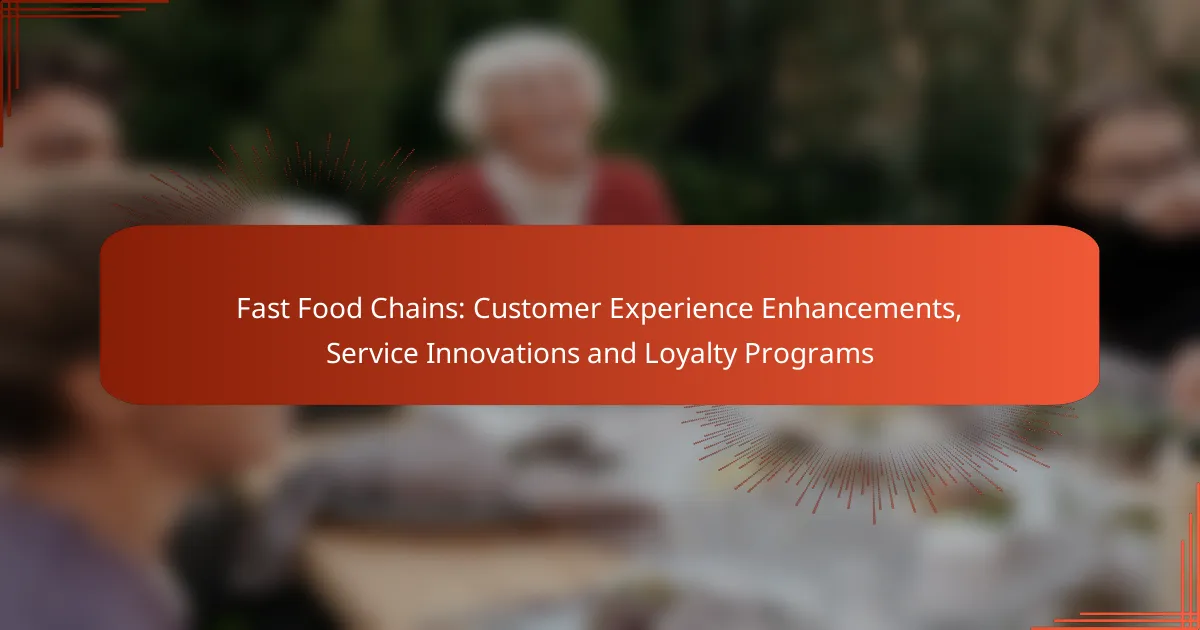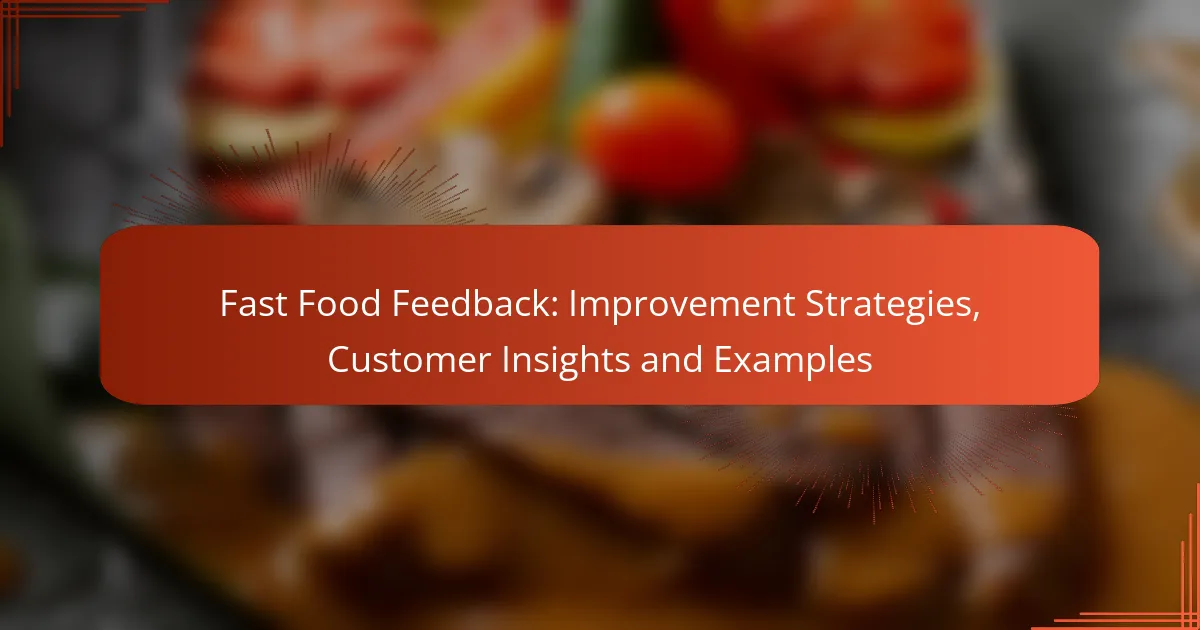Fast food chains are revolutionizing the customer experience by integrating technology and personalized services that enhance satisfaction and streamline ordering processes. With the adoption of innovations such as mobile apps, digital kiosks, and contactless payments, these establishments are meeting the evolving expectations of consumers. Additionally, loyalty programs are being implemented to reward repeat customers, fostering brand loyalty and encouraging retention through enticing rewards and exclusive offers.
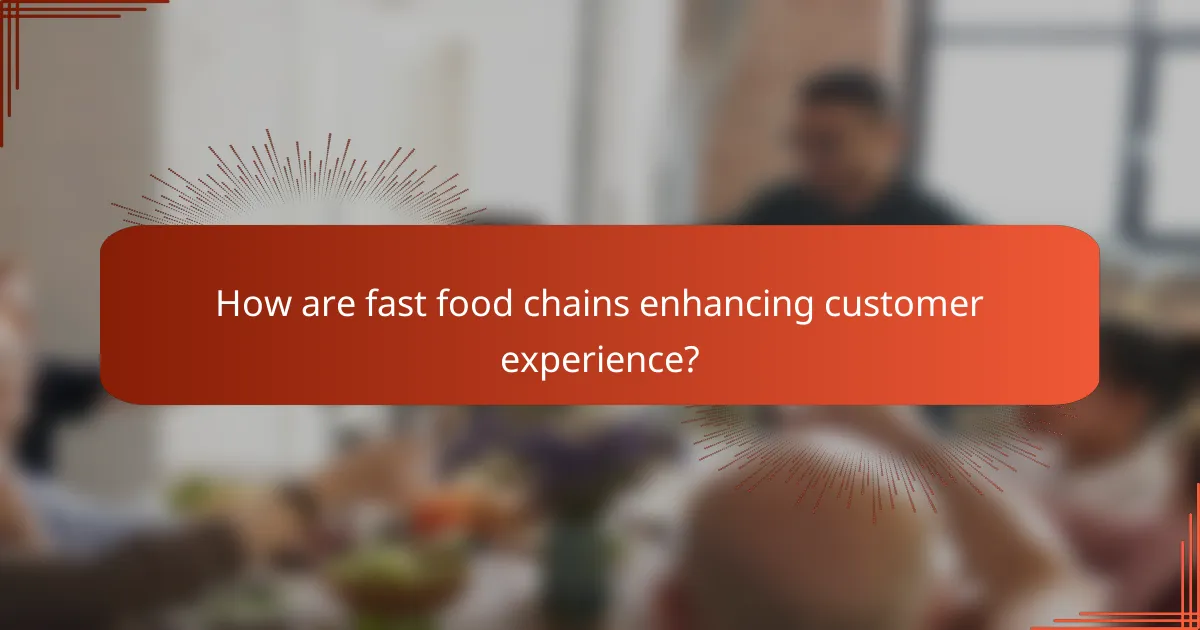
How are fast food chains enhancing customer experience?
Fast food chains are enhancing customer experience through technology and personalized services that streamline ordering and improve satisfaction. Innovations like mobile apps, digital kiosks, and tailored promotions are becoming standard practices to meet evolving consumer expectations.
Mobile ordering apps
Mobile ordering apps allow customers to place orders directly from their smartphones, reducing wait times and increasing convenience. Many chains offer features such as order customization, payment options, and loyalty rewards integration, making the process seamless.
For example, popular fast food brands often provide exclusive discounts for orders placed through their apps, encouraging users to adopt this technology. Customers can typically expect to receive their orders within a few minutes of arrival, enhancing the overall experience.
Personalized promotions
Personalized promotions leverage customer data to offer tailored discounts and deals based on individual preferences and purchasing history. This approach not only increases customer engagement but also drives repeat visits.
Fast food chains often use loyalty programs to track purchases and send targeted offers via email or mobile notifications. For instance, a customer who frequently orders burgers may receive a special discount on their next burger purchase, fostering loyalty and satisfaction.
In-store digital kiosks
In-store digital kiosks provide customers with an interactive way to place orders without waiting in line. These kiosks often feature user-friendly interfaces that allow for easy customization of menu items.
Many chains have reported increased order accuracy and faster service times due to the self-service nature of these kiosks. Customers can take their time to browse the menu and make selections, which can lead to higher average order values.
Customer feedback systems
Customer feedback systems enable fast food chains to gather insights directly from patrons about their dining experiences. This feedback can be collected through surveys, mobile apps, or in-store tablets, allowing for real-time improvements.
Chains often incentivize feedback by offering discounts or loyalty points, encouraging more customers to share their opinions. Analyzing this data helps companies identify trends and areas for improvement, ultimately enhancing customer satisfaction and retention.
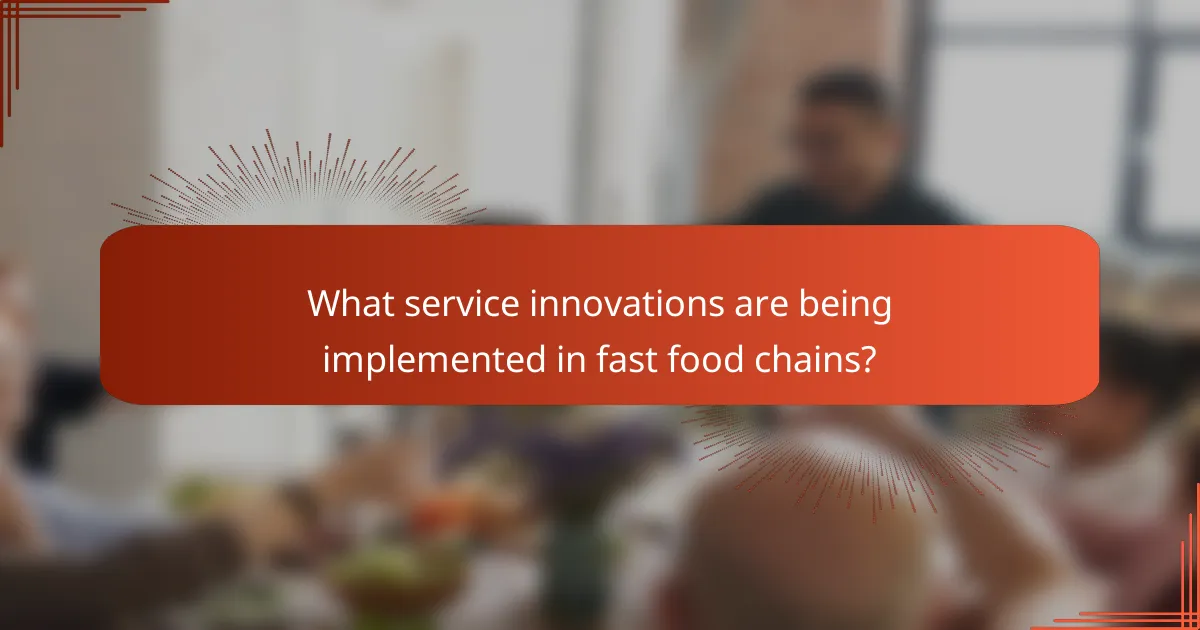
What service innovations are being implemented in fast food chains?
Fast food chains are increasingly adopting service innovations to enhance customer experiences and streamline operations. These innovations include contactless payment options, robotic food preparation, and AI-driven customer service, all aimed at improving efficiency and convenience for customers.
Contactless payment options
Contactless payment options allow customers to make transactions quickly and securely without physical contact. This method typically involves using NFC-enabled cards or mobile wallets like Apple Pay or Google Pay, which can speed up the checkout process.
Many fast food chains have integrated these systems to reduce wait times and enhance safety, especially during health crises. Customers can expect to see these options widely available, making it easier to pay in under a minute.
Robotic food preparation
Robotic food preparation involves using automated machines to cook and assemble food items, ensuring consistency and speed. This technology can handle tasks such as frying, grilling, and even assembling burgers, which can significantly reduce preparation times.
For example, some chains have implemented robotic fryers that can cook food to precise specifications, minimizing waste and improving quality. While the initial investment can be high, the long-term benefits include reduced labor costs and increased efficiency.
AI-driven customer service
AI-driven customer service utilizes artificial intelligence to enhance interactions with customers, often through chatbots or voice assistants. These systems can handle inquiries, take orders, and provide personalized recommendations based on customer preferences.
Fast food chains are leveraging AI to improve order accuracy and speed, with some systems capable of processing orders in just a few seconds. However, it’s important to ensure that these systems are user-friendly and can seamlessly transition to human assistance when needed.
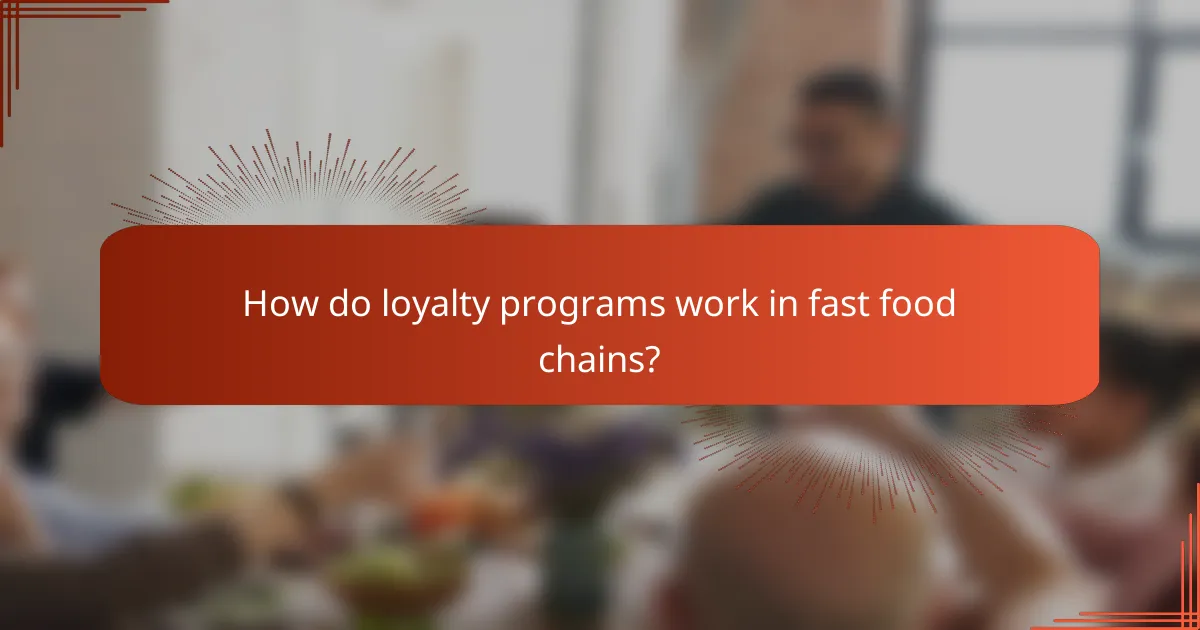
How do loyalty programs work in fast food chains?
Loyalty programs in fast food chains reward customers for repeat purchases, encouraging brand loyalty and increasing customer retention. These programs typically involve earning points or receiving discounts based on spending, which can be redeemed for free items or exclusive offers.
Points-based rewards systems
Points-based rewards systems allow customers to accumulate points with every purchase, which can later be exchanged for free food or discounts. For example, a customer might earn one point for every dollar spent, and once they reach a certain threshold, they can redeem points for a free meal. This system motivates frequent visits and larger purchases.
Many fast food chains use mobile apps to track points, making it easy for customers to see their progress and available rewards. It’s essential to check the expiration dates on points, as some programs may have a limited time frame for redemption.
Exclusive member discounts
Exclusive member discounts provide loyalty program participants with special pricing on menu items or limited-time offers. For instance, members might receive a 10-20% discount on select items or access to “members-only” deals that are not available to the general public. This creates a sense of exclusivity and encourages customers to join the program.
To maximize savings, customers should regularly check their fast food chain’s app or website for new discounts and promotions. Signing up for email notifications can also ensure that members stay informed about the latest offers.
Tiered membership benefits
Tiered membership benefits reward customers based on their spending levels, with higher tiers offering more significant perks. For example, a fast food chain might have three levels: Silver, Gold, and Platinum, where each tier unlocks better rewards such as larger discounts, free items, or priority service.
Customers should aim to understand the requirements for moving up tiers, as this can influence their spending habits. It’s advisable to evaluate whether the benefits of higher tiers justify the increased spending needed to achieve them, ensuring that the program aligns with personal dining preferences and frequency of visits.
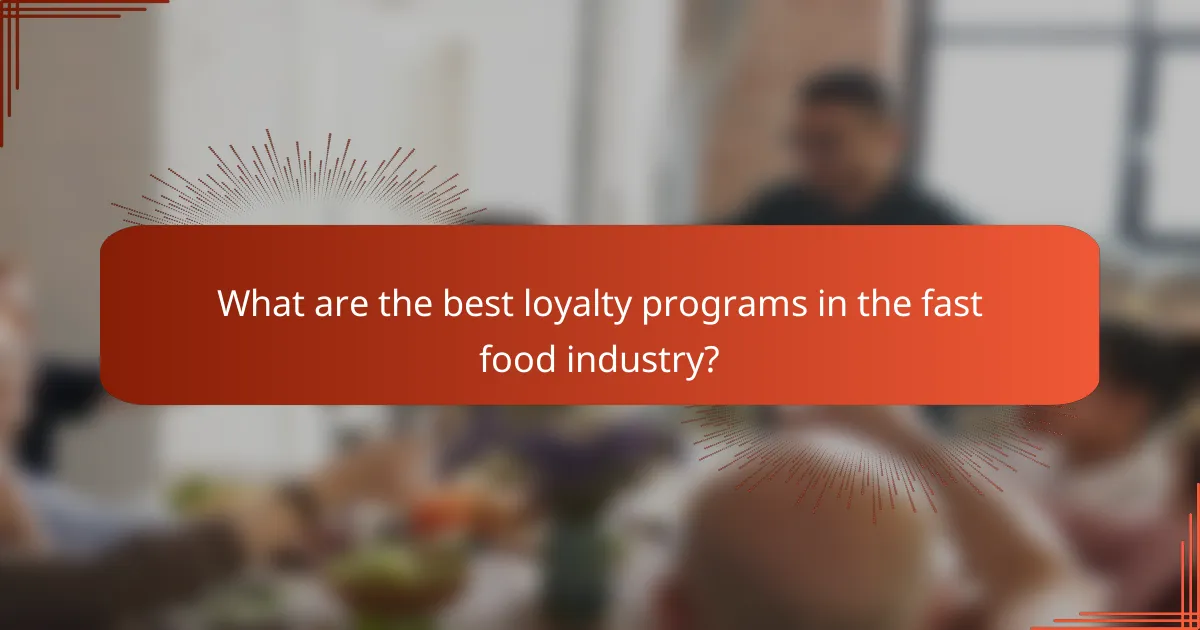
What are the best loyalty programs in the fast food industry?
The best loyalty programs in the fast food industry reward customers for their repeat business, offering points, discounts, or exclusive deals. These programs enhance customer experience by providing tangible benefits that encourage frequent visits.
Starbucks Rewards
Starbucks Rewards allows customers to earn stars for every purchase, which can be redeemed for free drinks and food items. Members also enjoy exclusive offers and can order ahead through the app, saving time during busy hours.
To maximize benefits, customers should consider using the Starbucks app for mobile orders, as this can lead to faster service and additional star bonuses. Regular promotions often provide opportunities to earn double stars on specific days or products.
Dunkin’ DD Perks
Dunkin’ DD Perks offers members points for every dollar spent, which can be redeemed for free beverages. Members also receive a free drink on their birthday and can enjoy exclusive promotions throughout the year.
To get the most out of DD Perks, customers should download the Dunkin’ app to track their points and receive personalized offers. Regularly checking the app can reveal limited-time promotions that enhance rewards potential.
Chick-fil-A One
Chick-fil-A One is a tiered loyalty program that rewards customers based on their spending. Members earn points for every dollar spent, which can be redeemed for free food items, and higher tiers unlock additional benefits like personalized rewards and exclusive offers.
To optimize the Chick-fil-A One experience, customers should register for the program via the app and place orders through it. This not only speeds up service but also allows members to receive tailored rewards based on their preferences and purchasing habits.

How do fast food chains compare in customer satisfaction?
Fast food chains vary significantly in customer satisfaction, influenced by factors such as service speed, food quality, and overall experience. Rankings from consumer surveys provide insights into which brands excel in meeting customer expectations.
Consumer Reports rankings
Consumer Reports evaluates fast food chains based on customer feedback regarding food quality, service, and cleanliness. These rankings often highlight brands that consistently deliver a positive dining experience, with scores typically ranging from low to high tens out of 100.
In recent years, chains like Chick-fil-A and In-N-Out Burger frequently top these rankings, praised for their service and food quality. Customers often cite friendly staff and efficient service as key reasons for their satisfaction.
J.D. Power customer satisfaction survey
The J.D. Power customer satisfaction survey assesses fast food chains by measuring customer perceptions of service, food quality, and value. Results are presented as a score out of 1,000, with top performers often scoring above 800.
Chains such as Dunkin’ and Taco Bell have shown strong performance in these surveys, reflecting their ability to meet customer needs effectively. Factors like menu variety and promotional offers also play a significant role in shaping customer satisfaction ratings.
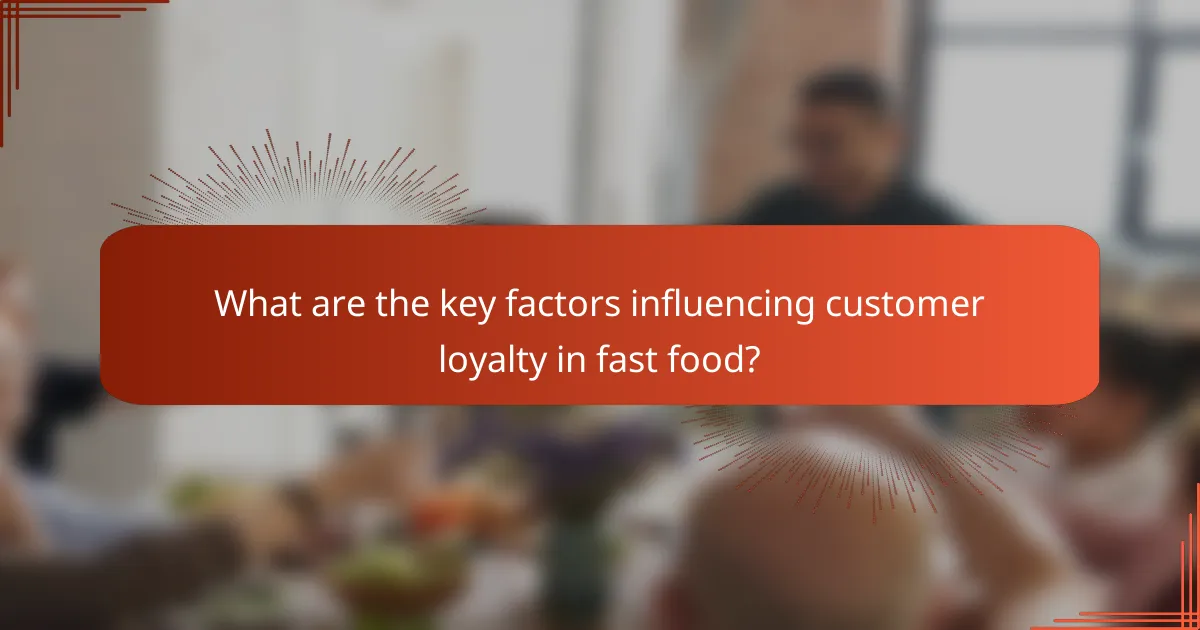
What are the key factors influencing customer loyalty in fast food?
Key factors influencing customer loyalty in fast food include the quality of food, service speed, pricing, and overall customer experience. Customers tend to return to establishments that consistently meet their expectations in these areas.
Quality of food
The quality of food is a primary driver of customer loyalty in fast food chains. Customers expect meals to be fresh, tasty, and prepared to a consistent standard. A focus on using quality ingredients can significantly enhance customer satisfaction.
Fast food chains often implement quality control measures to ensure that their offerings meet customer expectations. This may include regular taste tests, supplier audits, and adherence to food safety regulations. For example, a chain might prioritize sourcing local produce to improve freshness and flavor.
To maintain loyalty, fast food restaurants should regularly update their menu based on customer feedback and trends. Offering seasonal items or healthier options can attract new customers while retaining existing ones. Avoiding common pitfalls, such as inconsistent portion sizes or stale ingredients, is crucial for maintaining a loyal customer base.
